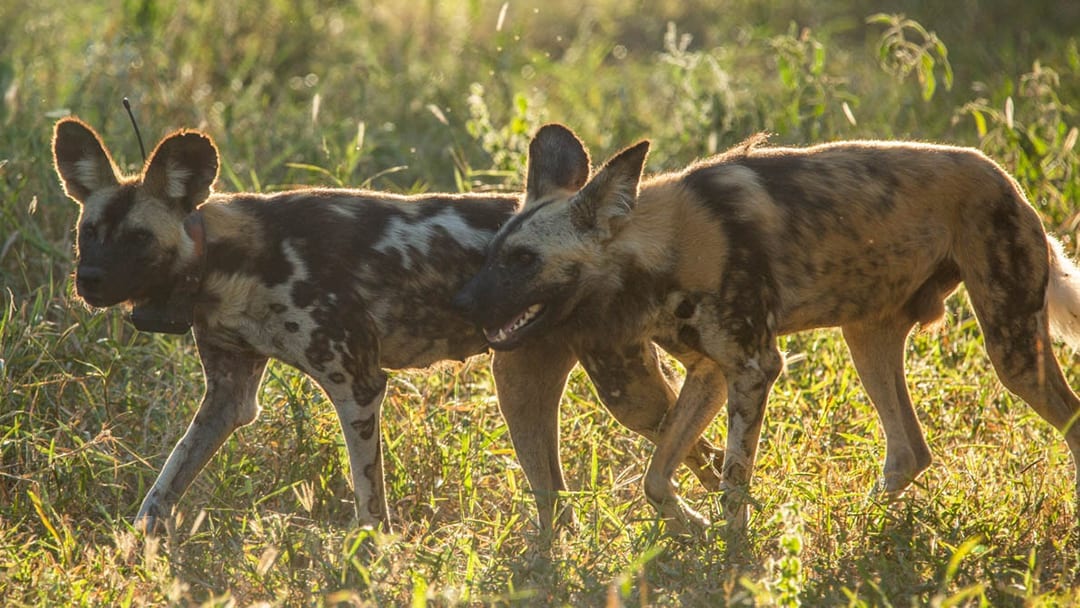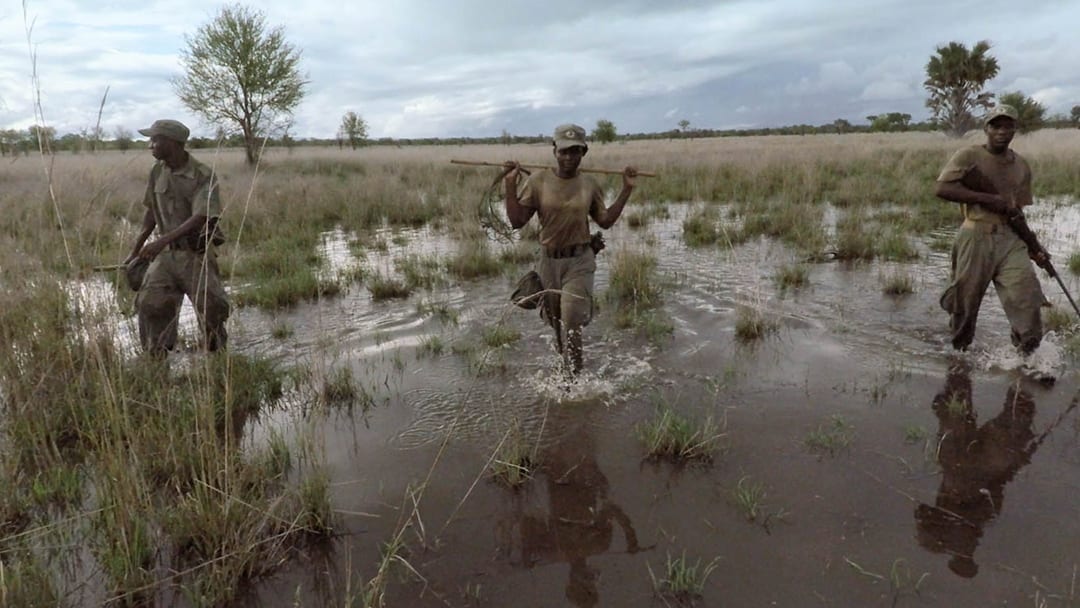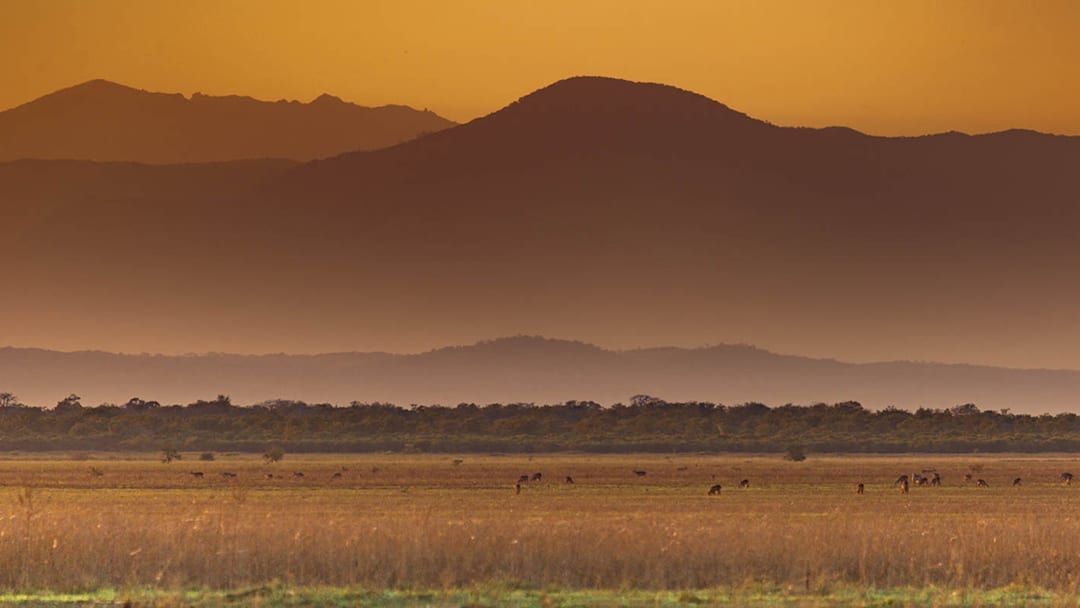Gorongosa National Park is open for tourist activities.
Contact us to book accommodation and activities via email at res@gorongosasafaris.com. Welcome!
Carnivore Recovery

Carnivore Recovery, Wildlife Veterinary, Re-introductions
Our specialized team includes vets and ecologists who specialize in the protection and recovery of key species such as lions, painted wolves, pangolin, elephant and others.
We launched the first research-based, long-term, large-carnivore conservation project in the history of the Park in 2012 and we focus strongly on recruiting and nurturing the next-generation of wildlife scientists, veterinarians and conservationists from Mozambique. In 2018, we reintroduced our 1st pack of Painted Wolves –– a critically endangered carnivore species indigenous to the Park. Leopard are soon to follow. We closely monitor our recovering, indigenous lion population. Dr. Antonio Paulo and Dr. Mercia Angela are our two Mozambican veterinarians who co-lead most field operations involving lion, wild dog, leopard and elephant.
Lion populations stills face very deep challenges across the continent, Mozambique is no exception; Poaching (specifically related to the bushmeat trade) and habitat encroachment are the largest threats to our population at this time, one threats we constantly have to counter.. Our work is all-consuming, difficult, and emotionally fraught. With the crisis in Lion numbers in the wild across Africa, every lion matters. Every lion counts. Each birth is a celebration and each unnecessary death a tragedy. Preparation of trained teams of rangers and veterinarians means we can now protect lions and many other species and realize the stronghold that Gorongosa once was for the species.
Our close collaboration with the rangers of Gorongosa means we can actively put our research to work towards species recovery. For example, when we launched our research back in 2012 it was believed that there were only 30-40 lions in the Park. Today, in 2019, we have documented at least 146 lions across the Park and dozens of new cubs. This tripling of the lion population represents both a lion recovery brought about by the rangers ensuring the integrity of the Park as well as the increasing ability of our team to closely monitor the species across a vast wilderness with very little road access.


Over the past 3 years, we took a more active approach to carnivore recovery, launching patrols to focus on anti-poaching in core lion areas we identify with the use of GPS-collars. Our teams systematically “sweep” and secure well defined blocks to find and remove snares, and creating “safe zones” – these sweeps ensure the habitat is safe for all species, but as a result there has been a 95% reduction in snaring of lions and a 65% decline in snares and traps that once killed and maimed 1/3 of lions.
Wildlife numbers in Gorongosa have been steadily climbing since the beginning of the Project, and the results of the 2018 aerial survey showed encouraging growth of large mammal populations. Some species naturally endemic to the Greater Gorongosa Area however, are in need of additional support, and the Project is working on the reintroduction of several species of herbivore and carnivore to help balance the complex interplay of animals in the ecosystem.
Another important component of ecosystem restoration is expanding the conservation footprint to beyond the current boundaries of the Park. In 2017, we entered in a formal agreement with Entroposto, who are devolving themselves of an area north of the Park that used to be called Coutada 12 – An area that was one a hunting ground where wildlife was shot – and will now become part of the larger Gorongosa Region, enabling wildlife to thrive, and someday to reclaim ancient migration corridors that once led from the Mountain to the Mangroves.
In addition, we are working closely with a large forestry concession to expand the area even further – We plan to have an additional ranger force there this year, combatting poaching and illegal logging, and we know that these areas are already home to leopard, wild dog and hyena – species that had once been common in the Park, but were extirpated during the civil war.
The goals of this expansion is to extend the area under protection, and to establish wildlife corridors that will provide enough space for the animals to thrive and survive. In addition, this approach will help solidify an integrated approach to law enforcement.

We hope in the next few years to link Mt Gorongosa to the Pacific ocean, supporting the next several generations of wildlife and humans that depend on this landscape.
Out last two aerial wildlife counts have shown that overall wildlife is rebounding in the Park (though some species have declined due to the recent drought) The waterbuck population have continued to increase and now number over 45,000. Impala, kudu and nyala have also increased substantially since 2014. We are very proud that our sable population is now over 800 individuals strong, with upward trends. Elephant and buffalo numbers also continue to grow.
In fact, we are delighted to be now be in a position to be able to help other depleted conservation areas in Mozambique. In 2016 a total of 412 waterbuck, 99 warthogs and 53 reedbuck were captured and relocated to Zinave National Park and Maputo Special Reserve in 2016. This year, a further 400 waterbuck and 100 reedbuck were relocated to Zinave, and approximately 600 waterbuck and 100 warthogs were translocated to Maputo Special Reserve
Our lion population is growing and is continuously monitored throughout the core study area by means of satellite-collars, trail cameras and direct observations. Planning and coordination of a newly launched Leopard Recovery Strategy took place for reintroduction of wild leopards, including a collaring operation, and corridor assessment of leopard numbers. We continue to track the ecological changes and succession, and celebrate as Gorongosa National Park rehabilitates.
Our Mission
Our Mission
Advance an integrated multi-partner approach to conservation and to people-centred development. The Gorongosa Project protects the Park’s biodiversity and ecosystem services and unlocks its economic potential for the community inhabitants of the Gorongosa Buffer Zone, Sofala Province, Mozambique and further afield.
Our Vision
A thriving, biodiversity-rich, Greater Gorongosa conservation landscape, which supports Sofala Province as an engine for resilient and sustainable development enabling nature experiences and wellbeing for its people, enriching all of Mozambique and the world.
A Park for Peace
On 1 August, 2019 a historic ceremony was held in Gorongosa to celebrate the Cessation of Hostilities Accord between the leaders of the Government of Mozambique and the opposition Renamo Party. The accord established Gorongosa National Park (GNP) as a ‘Park for Peace’, delivering human development to the communities that share the greater landscape.
Ethics and Compliance
The Ethics and Compliance e-mail is a reporting mechanism that facilitates reporting of possible illegal, unethical, or improper conduct from staff, suppliers and stakeholders. The e-mail is Ethics@gorongosa.net